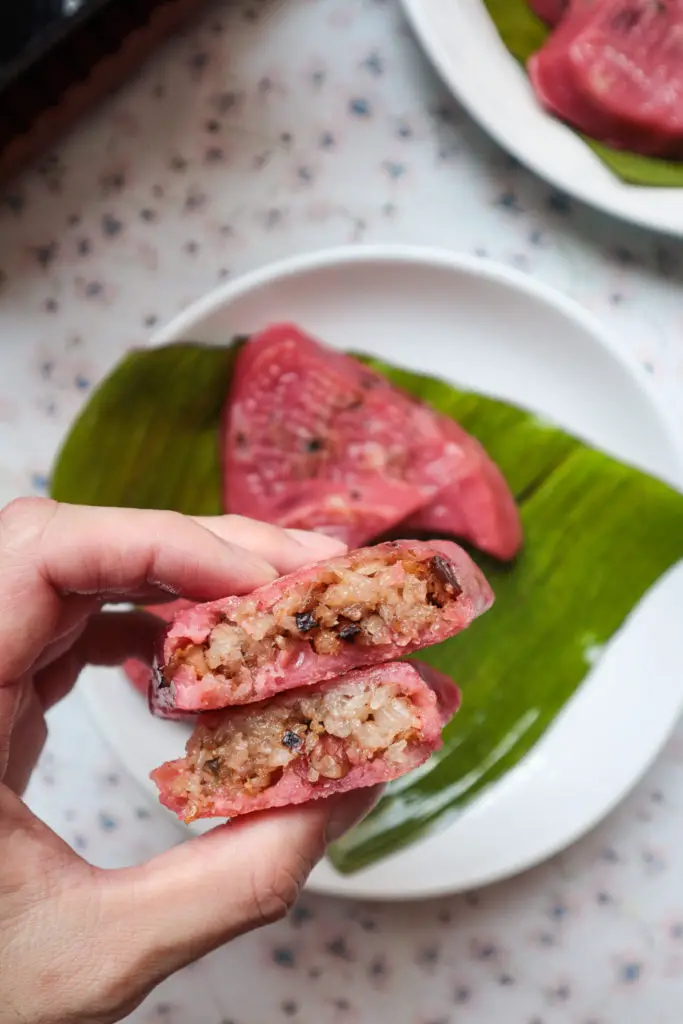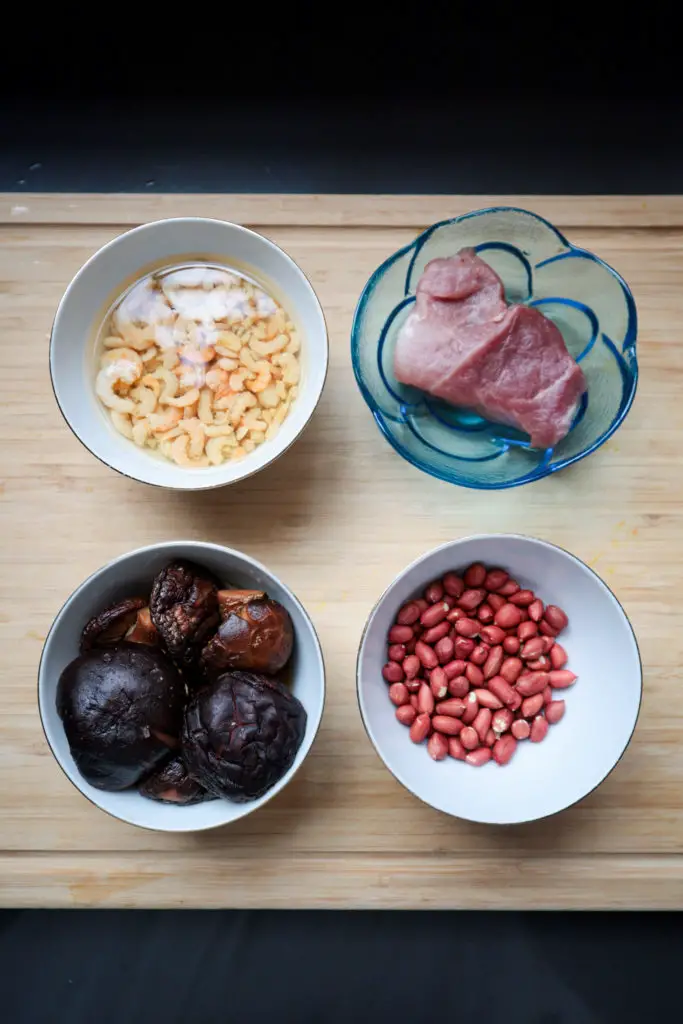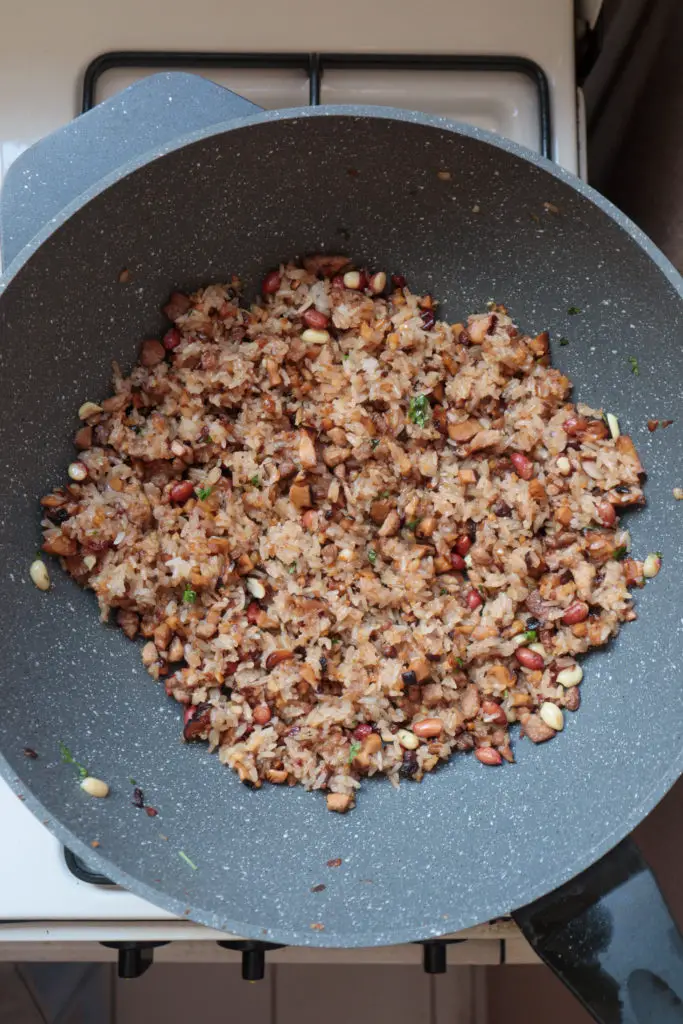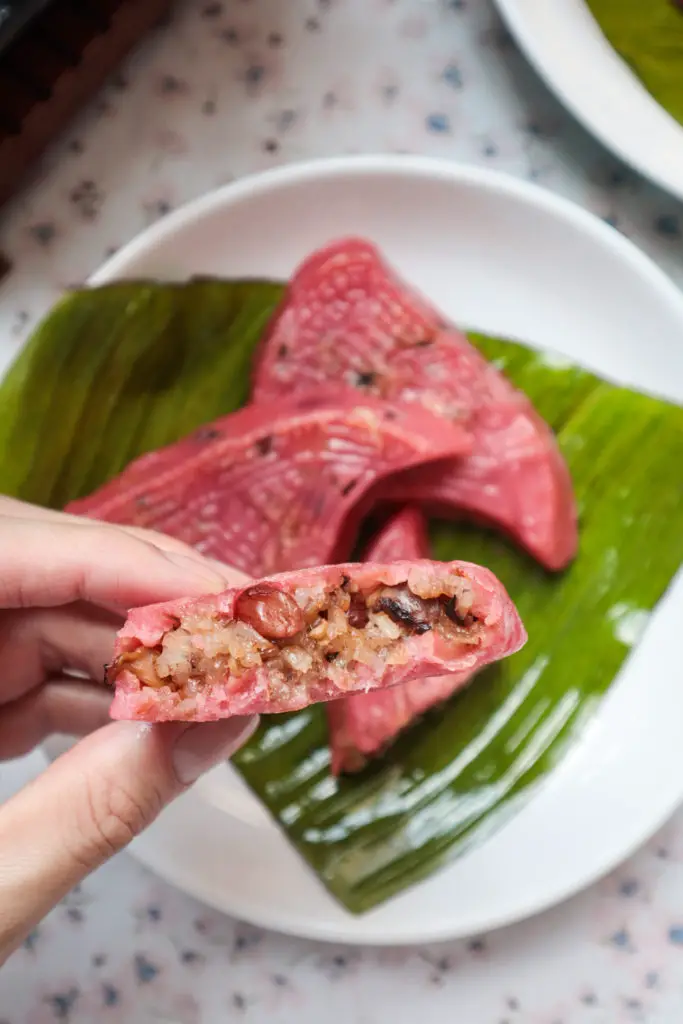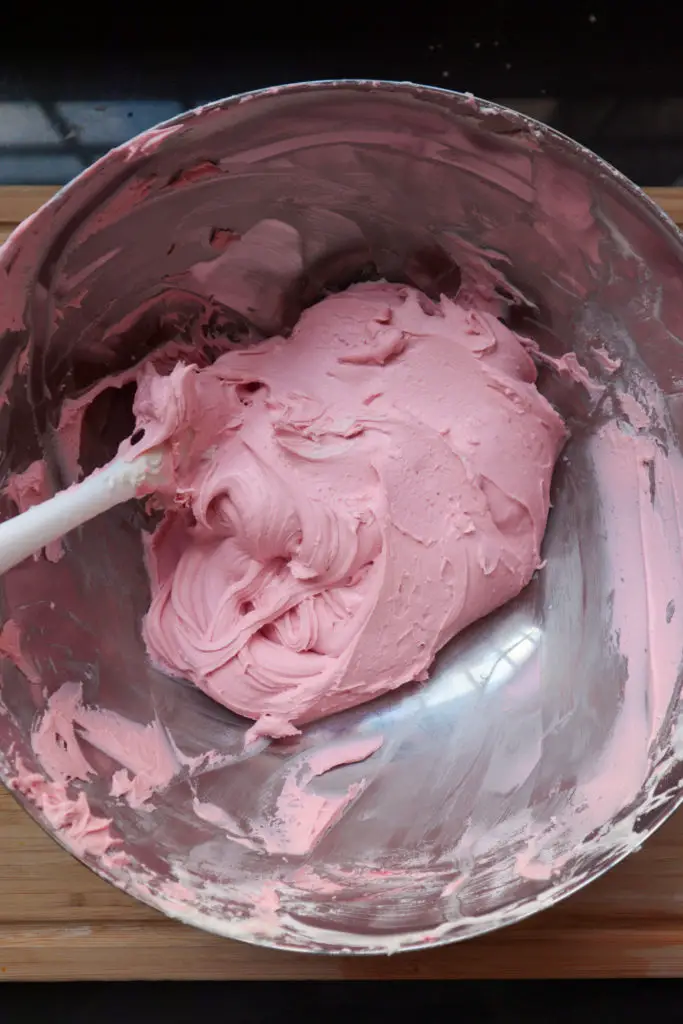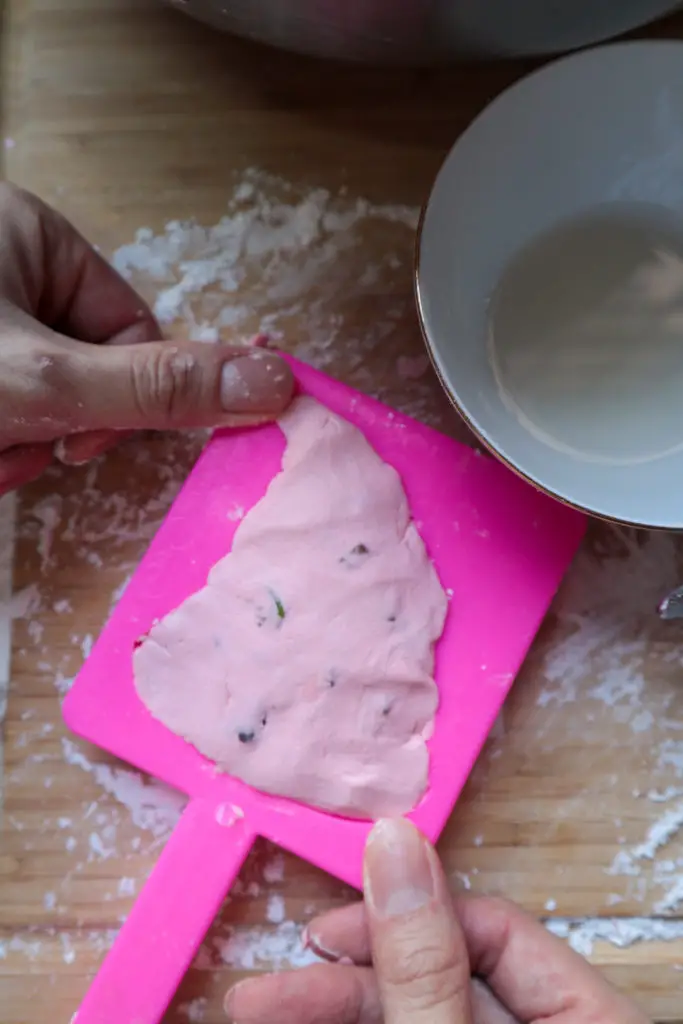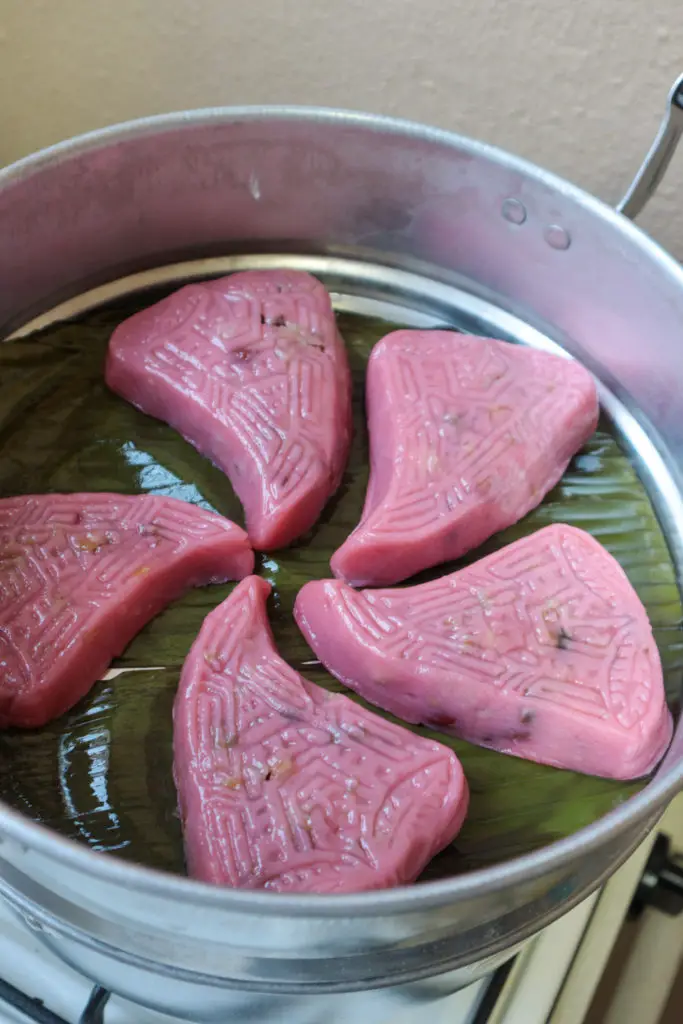“Teochew nang,
ka cheng ang ang,
Kaki nang,
Pak si boh siang kang.”
– A famous Teochew saying
(Translation: Teochew people,
Have red backsides,
To beat one of our own to death;
Is not a problem)
If you ever meet a Teochew, chances are – they will be familiar with the saying above. Witty musings aside, the Teochews are also known for their cuisine, especially braises dishes and the very humble Teochew porridge.
In this post, we learn to make a lesser known but delicious Teochew treat called Png Kueh 潮州饭桃.
Savoury rice dumplings
Png Kueh is Max’s favourite childhood snack.
Pronounced as Perng with a silent “R” this kueh literally means rice peaches in Teochew.
It is a savoury dumpling which contains glutinous rice, peanuts, mushrooms and dried shrimps.
A traditional snack originating from the Teochew community, these kuehs are not as famous as other kuehs in Malaysia. In fact, many of our friends (including those of Teochew descent) have not tried these.
Peach-shaped snacks
Shaped into a peach (which signifies longevity and immortality in Chinese), these kuehs are often sold in pink or white coloured skins made from rice flour.
The colours are symbolic. The pink kuehs represent joy and are usually served as offerings to heavenly gods, while the white ones are offered to ancestors residing in hell.
Hence, white png kuehs are usually adorned with a simple red dot to ensure they are of the auspicious kind.
Pan-fry for crispy skin
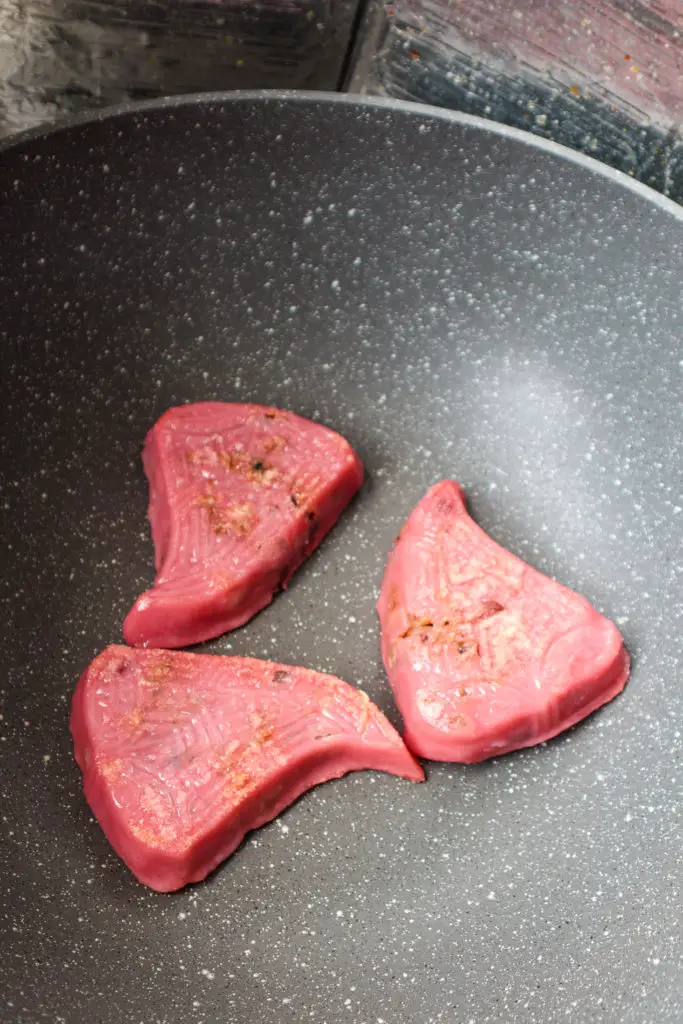
Pan-fry for charred skin 

Pan-fried vs. steamed dumplings
When Max was younger, his paternal Teochew grandma used to bring home these png kuehs bought from the wet market. The best way to eat these is to pan-fry them until slightly brown and charred.
This results in a lovely caramelised crisp skin, while the inner skin and filling remained soft and tender.
However, these kuehs are rarely sold these days – hence, we have decided to make them ourselves.
Delicious filling
These png kuehs are extremely delicious. The filling mainly consists of glutinous rice, with flavours coming from dried shrimps, mushrooms, and chye poh (fermented radish).
The skin is made from rice flour (not glutinous rice flour, mind you) – hence, it makes sense that these delectable treats are called “rice peaches”.
If you haven’t tried png kuehs before, the flavours are pretty close to the well-known Cantonese ‘loh mai fun’ dish, except ours are wrapped in dumpling skin.
Although the traditional recipe includes chye poh (fermented radish), we omitted them as our family does not like the fermented vegetable.
Traditional png kuehs also do not contain any meat, but we included some pork bits for extra protein. Any cut is acceptable as long as it can be finely diced.
Chinese celery leaves are a key ingredient for png kueh – but feel free to swap it out with coriander leaves if you can’t find them.
Where to get the mould?
You’ll need the peach-shaped mould to accurately make the png kuehs. You should be able to get these from Lazada or traditional Chinese shops that sell cookware and cockery.
A labour of love
It requires a lot of preparation and work to make these traditional kuehs. Firstly, you’ll need to rinse and soak the glutinous rice overnight. This is to ensure the rice cooks and absorbs the moisture evenly.
Secondly, you’ll need time to cook the filling, make the dumplings, and finally steam them in batches. As such, these png kuehs were usually cooked as a family to celebrate festivals and special occasions.
Key tips
The key steps are detailed in the recipe below, but we want to highlight some important tips here.
1. If you can’t soak the rice overnight, soak them for at least four hours.
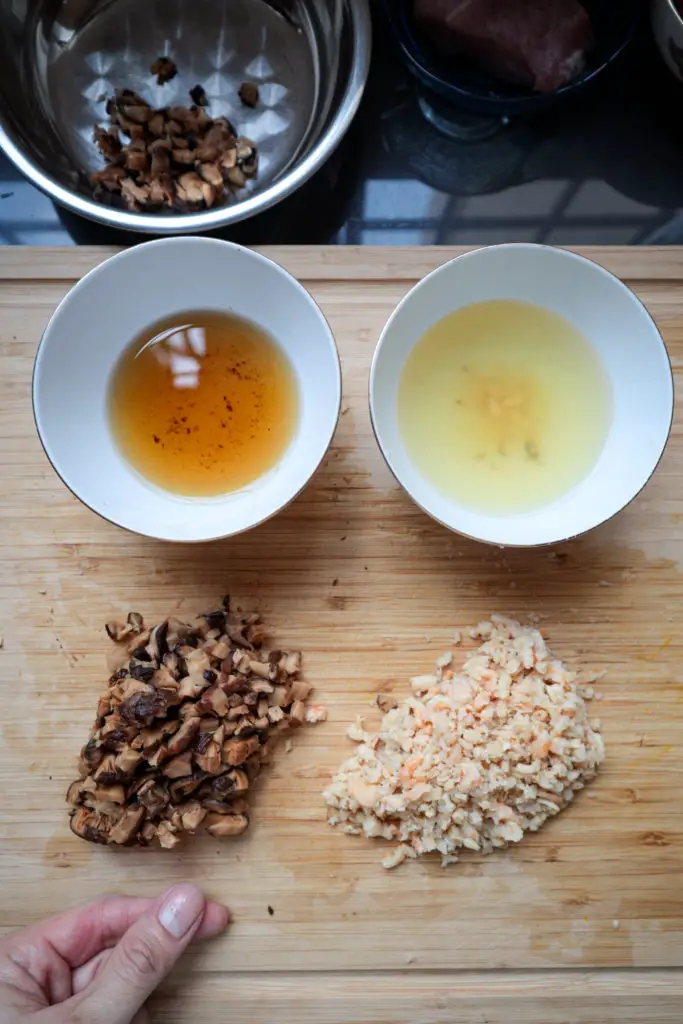
Retain water used to soak mushrooms and shrimps 
2. Retain the water used to soak the mushrooms and shrimps and add them when cooking the filling. This will add moisture and provide some natural umami flavour.
3. When making the dough, slowly add the freshly boiled water into the rice flour. Allow it to rest for five minutes to enhance the stickiness when kneading the dough.
4. Grease hands with oil and rub with some flour when making the dumplings to prevent them from sticking to your end. Ensure that each kueh has generous filling, with every ingredient present.
5. Finally, brush the kuehs and banana leaf lightly with oil before steaming to prevent them from sticking to the rack, and the protect the skin from breaking.
6.Any kuehs that have been freshly shaped should not be left out too long or the skin will dry out. Hence, we recommend making enough kuehs to fit your steamer’s capacity, and making them in batches.
How to store the kuehs
Once the kuehs are cooked, allow them to cool down and serve immediately.
Our favourite way to enjoy the kuehs is to pan-fry them after to get crispy skin.
Steamed kuehs can be stored in the fridge for a week, or in the freezer for a month. The skin will harden once stored.
To enjoy them, simply reheat in a steamer or microwave until they are soft and warm.
Follow us on Instagram
Follow us on Instagram for the latest recipes and food adventures.
Check out the video for this recipe in the Instagram reel below.
Key steps in pictures
Teochew Png Kueh RECIPE
Course: Lunch, Dinner, SnacksCuisine: Teochew, ChineseDifficulty: Intermediate10
servings1
hour30
minutes40
minutesLet’s make Teochew Png Kueh. These are rice dumplings shaped into peaches with delicious filling of glutinous rice, mushrooms and shrimps. This recipe yields about 18 dumplings.
Ingredients
- Filling
250g glutinous rice, rinsed and soaked overnight
50g dried shrimps, soaked and minced
5 dried shiitake mushrooms, soaked and diced
3 garlic cloves, minced
5 shallots, thinly sliced
50g peanuts
100g pork shoulder/loin, diced
(marinated with 1/2 tsp soy sauce and a dash of pepper)30g chye poh (optional)
1 tsp of Chinese celery leaves, finely cut
cooking oil
- Seasoning
1 tbsp light soy sauce
1/2 tbsp sesame oil
salt and pepper to taste
3-4 tbsp of water used to soak shrimps and mushrooms
- Dumpling skin
380g rice flour
500ml freshly boiled water
150g tapioca starch
1/2 tsp salt
1-2 drops of red food coloring
1 tsp oil
- Other ingredients/utensils
Peach-shaped mould
Banana leaves
Directions
- Soak rice the day before
- Rinse glutinous rice 2-3 times. Soak rice in water overnight or for 4 hours at least before cooking.
- Cook rice and prepare mushrooms and shrimps
- Once the rice is ready, drain excess water. Place rice in a steaming dish and add water into steamer. Steam over high heat for 30 minutes. Remove when done and allow rice to cool down.
- While waiting for rice to cook, rinse and soak the dried shrimps and dried mushrooms in water until soft. Dice the mushrooms and mince the dried shrimps. Please retain the water used to soak the mushrooms and shrimps.
- Cook fillings
- Add 1-2 tbsp of cooking oil into a wok over medium heat. Fry the garlic, shallots, dried shrimps (and chye poh, if using) until fragrant.
- Add the marinated pork and fry for 2-3 minutes.
- Add the mushrooms, steamed rice, and peanuts.
- Add 3-4 tbsp of water used to soak the mushrooms and shrimps. You may add more water if you prefer more moisture. Mix well. The rice should not be too mushy or dry.
- Add light soy sauce, sesame oil, salt and pepper. Adjust to taste. Turn off fire and add the Chinese celery leaves. Mix well.
- Once done, set aside to let it cool down.
- Prepare dough
- Place 380g of rice flour in a bowl and slowly mix in 500ml of fresh boiled water. Use a spatula to avoid getting burnt. Once done, cover with lid and allow dough to rest for 5 minutes.
- Slowly fold in 150g of tapioca flour. Once done, add 1-2 tbsp of red food colouring, salt and oil. Mix well until you get pink dough.
- Use your hands to knead the dough. You may grease your hand with oil or brush with some flour to ease the kneading process.
- Knead until dough is smooth and sticky. Cover bowl with damp cloth to prevent dough from drying out.
- Making the dumplings
- Dust some flour over the mould, and grease hands with oil and flour to ease the process.
- Take a handful of dough, flatten it into a round shape on the palm (you may use a rolling pin).
- Place a spoonful of filling in the middle (the amount will depend on the size of your mould). Slowly, fold over and pinch the edges together to cover the filling. Roughly shape the dumpling into a triangle shape.
- Press the dumpling into the mould firmly, ensuring that it fills up the cavity.
- Turn the mould over, and gently knock out the dumpling.
- We recommend making the dumplings in batches to fit your steamer’s capacity.
- It’s steaming time!
- Place a banana leaf in the steamer rack and brush it lightly with oil. This will prevent the kuehs from sticking to the rack.
- Brush the kuehs with oil and place them onto the steamer rack.
- Steam over medium heat for 15 minutes. Remove when done.
- Make and steam kuehs in batches until the dough and filling had finished.
- Allow kuehs to cool down and enjoy.
- Bonus step!
- Lightly pan fry the kuehs with some oil until the skin is slightly brown and crispy.



